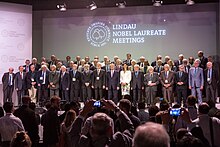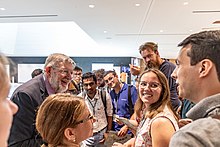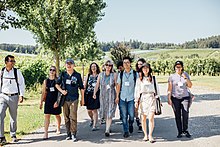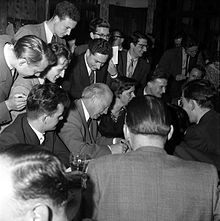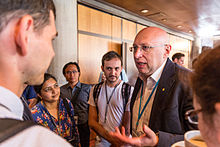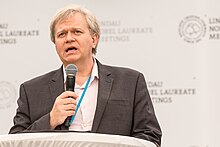
Carl Peter Henrik Dam was a Danish biochemist and physiologist.

Lindau is a major town and island on the eastern side of Lake Constance in Bavaria, Germany. It is the capital of the county (Landkreis) of Lindau, Bavaria and is near the borders of the Austrian state of Vorarlberg, and the Swiss cantons of St. Gallen and Thurgau. The coat of arms of Lindau town is a linden tree, referring to the supposed origin of the town's name. The historic town of Lindau is located on the 0.68-square-kilometre (0.26 sq mi) island of the same name, which is connected with the mainland by a road bridge and a railway causeway leading to Lindau station.

Claude Cohen-Tannoudji is a French physicist. He shared the 1997 Nobel Prize in Physics with Steven Chu and William Daniel Phillips for research in methods of laser cooling and trapping atoms. Currently he is still an active researcher, working at the École normale supérieure (Paris).

Peter Agre is an American physician, Nobel Laureate, and molecular biologist, Bloomberg Distinguished Professor at the Johns Hopkins Bloomberg School of Public Health and Johns Hopkins School of Medicine, and director of the Johns Hopkins Malaria Research Institute. In 2003, Agre and Roderick MacKinnon shared the 2003 Nobel Prize in Chemistry for "discoveries concerning channels in cell membranes." Agre was recognized for his discovery of aquaporin water channels. Aquaporins are water-channel proteins that move water molecules through the cell membrane. In 2009, Agre was elected president of the American Association for the Advancement of Science (AAAS) and became active in science diplomacy.
The Mainau Declaration is either of two socio-political appeals by Nobel laureates who participated in the Lindau Nobel Laureate Meetings, the annual gathering with young scientists at the German town of Lindau. The name denotes that these declarations were presented on Mainau Island in Lake Constance, the traditional venue of the last day of the one-week meeting.

John Lewis "Jan" Hall is an American physicist, and Nobel laureate in physics. He shared the 2005 Nobel Prize in Physics with Theodor W. Hänsch and Roy Glauber for his work in precision spectroscopy.

The German Physical Society is the oldest organisation of physicists. The DPG's worldwide membership is cited as 52,220, as of 2022, making it one of the largest national physics societies in the world. The number of the DPG's members peaked in 2014, when it reached 63,000, but it has been decreasing since then. It holds an annual conference and multiple spring conferences, which are held at various locations and along topical subjects of given sections of the DPG. The DPG serves the fields of pure and applied physics. Main aims are to bring its members and all physicists living in Germany closer together, represent their entirety outwards as well as foster the exchange of ideas between its members and foreign colleagues. The DPG binds itself and its members to advocate for freedom, tolerance, veracity and dignity in science and to be aware about the fact that the people working in science are responsible to a particularly high extent for the configuration of the overall human activity.

Rainer Blatt is a German-Austrian experimental physicist. His research centres on the areas of quantum optics and quantum information. He and his team performed one of the first experiments to teleport atoms, the other was done at NIST in Boulder Colorado. The reports of both groups appeared back-to-back in Nature.

Brian Paul Schmidt is a Distinguished Professor and astrophysicist at the University's Mount Stromlo Observatory and Research School of Astronomy and Astrophysics. He was the Vice-Chancellor of the Australian National University (ANU) from January 2016 to January 2024. He is known for his research in using supernovae as cosmological probes. He currently holds an Australian Research Council Federation Fellowship and was elected a Fellow of the Royal Society (FRS) in 2012. Schmidt shared both the 2006 Shaw Prize in Astronomy and the 2011 Nobel Prize in Physics with Saul Perlmutter and Adam Riess for providing evidence that the expansion of the universe is accelerating, making him the only Montana-born Nobel laureate. He was previously an Australian Research Council Laureate Fellow.

Gerhard Ertl is a German physicist and a Professor emeritus at the Department of Physical Chemistry, Fritz-Haber-Institut der Max-Planck-Gesellschaft in Berlin, Germany. Ertl's research laid the foundation of modern surface chemistry, which has helped explain how fuel cells produce energy without pollution, how catalytic converters clean up car exhausts and even why iron rusts, the Royal Swedish Academy of Sciences said.

Jules Alphonse Nicolas Hoffmann is a Luxembourg-born French biologist. During his youth, growing up in Luxembourg, he developed a strong interest in insects under the influence of his father, Jos Hoffmann. This eventually resulted in the younger Hoffmann's dedication to the field of biology using insects as model organisms. He currently holds a faculty position at the University of Strasbourg. He is a research director and member of the board of administrators of the National Center of Scientific Research (CNRS) in Strasbourg, France. He was elected to the positions of Vice-President (2005-2006) and President (2007-2008) of the French Academy of Sciences. Hoffmann and Bruce Beutler were jointly awarded a half share of the 2011 Nobel Prize in Physiology or Medicine for "their discoveries concerning the activation of innate immunity,". [More specifically, the work showing increased Drosomycin expression following activation of Toll pathway in microbial infection.]

The Konrad Lorenz Institute for Evolution and Cognition Research (KLI) is an international center for advanced studies in the life and sustainability sciences. It is a "Home to Theory that Matters" that supports the articulation, analysis, and integration of theories in biology and the sustainability sciences, exploring their wider scientific, cultural, and social significance. The institute is located in Klosterneuburg, near Vienna, Austria. Until 2013, the institute was located in the family mansion of the Nobel Laureate Konrad Lorenz in Altenberg. Lorenz' work laid the foundation for an evolutionary approach to mind and cognition.

Martin Lee Chalfie is an American scientist. He is University Professor at Columbia University. He shared the 2008 Nobel Prize in Chemistry along with Osamu Shimomura and Roger Y. Tsien "for the discovery and development of the green fluorescent protein, GFP". He holds a PhD in neurobiology from Harvard University.
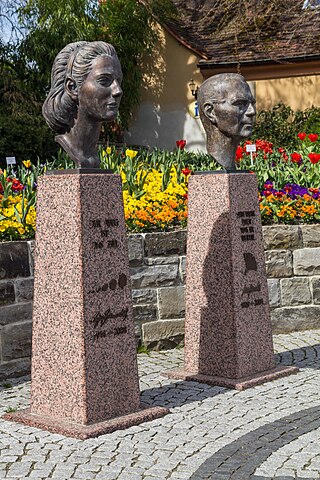
Sonja Anita Maria Bernadotte, Countess of Wisborg was an estate manager and the second wife and widow of Count Lennart Bernadotte, son of Prince Wilhelm of Sweden.

The Vega Science Trust was a not-for-profit organisation which provided a platform from which scientists can communicate directly with the public on science by using moving image, sound and other related means. The Trust closed in 2012 but the website and streaming video remains active.

The Asian Science Camp (ASC) is an annual forum for pre-collegiate and college students which aims at promoting discussion and cooperation among Asian students for the betterment of science in the Asian region. The first ASC was held at Taipei in 2007, and was subsequently held at Bali in 2008, Tsukuba in 2009, Mumbai in 2010, Daejeon in 2011, and Jerusalem in 2012, among others. This idea of an annual camp was co-proposed by Yuan Tseh Lee and Masatoshi Koshiba at the 2005 Lindau Nobel Laureate Meeting. The ASC is modeled after the Lindau meetings.
The Australian Academy of Science National Committees represent the established, emerging and interdisciplinary scientific fields in Australia.

The German Society for Plant Sciences is a non-profit network for plant sciences and botany in the German-speaking area. It was founded 1882 at Eisenach, Germany. In July 2020 it comprises more than 900 individual members and persons working or interested in plant science. The society supports young scientists and unites all generations.

The Academy of Sciences Malaysia is a statutory body in the Malaysian government established under an act of Parliament. The Academy, abbreviated as ASM, is the highest scientific advisory body of Malaysia, and is organizationally under the Ministry of Science, Technology and Innovation (MOSTI).
AcademiaNet is an international database containing profiles of women scientists. It is a non-profit project with the goal to raise the share of women in leadership positions in academia. AcademiaNet was initiated in 2010 in Germany by the Robert Bosch Stiftung and the publishing house "Spektrum der Wissenschaft". The Swiss National Science Foundation assumed responsibility of the platform in 2020.
